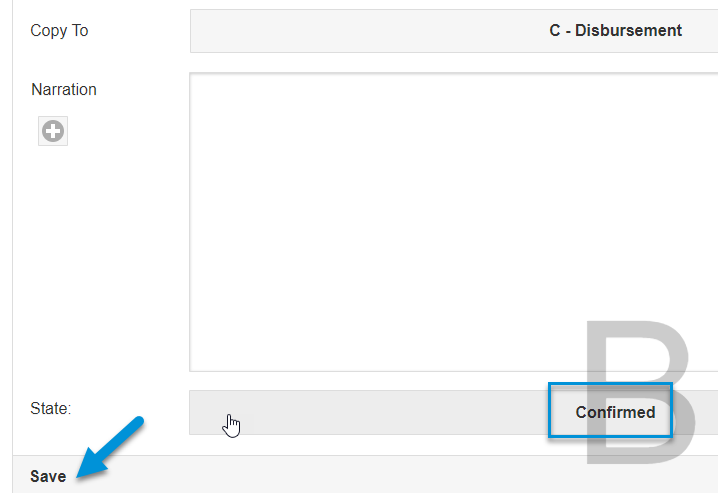July 2021
Welcome to the second release of 2021, TimeTrak 21.2. Please browse through this document to find out more.
TimeTrak version 21.1 onwards has a new requirement for websites to be secure (https). For a full list of requirements, please review here;
Table of Contents
1.TimeTrak Resources Tab displays on all jobs within TimeTrak now
2. Work Group Changes
3. Ability to select multiple appointments and ‘convert’ to time entries in Professional.
4. Ability to update multiple appointments and time entries in Professional via shortcut keys.
5. Changes to Rosters
6. TimeLine Changes
7. Ability to set a colour against a client in TimeTrak to define appointment colour based on the client
8. New ‘Pin Job’ functionality from an existing time entry/ appointment
9. New Default User Fields and the ability to edit these in TimeTrak Professional
10. Verification Changes
11. Changes to fill day behaviour
12. “Shared” Event based draft checklists
13. New Quote “State” – Only “Confirmed” Quote lines to Sync back to MYOB Acumaticad.
With the release of version 20.1, which included project management features a “Resources” tab was added to jobs marked as “Projects” within TimeTrak.
For more information on this click here.
From version 21.2 onwards, the TimeTrak resource tab will display against all jobs apart from sub-jobs where the resources will flow through from those against the master (parent) job.

Resources that display against this tab will be limited to group(s) the logged in user has access to, i.e. Global Administrator (Access to all groups and all users). Otherwise, only groups that are assigned to the logged in user via the “Groups” tab of the user profile in the Admin Console will display.
Users report under the group that is marked as their default.
New Control Change:
In 21.2, the Workgroup form has been updated and we have removed the buttons for add/remove and move up/down.
Now the selected users display as being already selected in the Available Users list on the left. The position of users on the calendar can be re-arranged by dragging the users to the position required on the Users panel on the right.
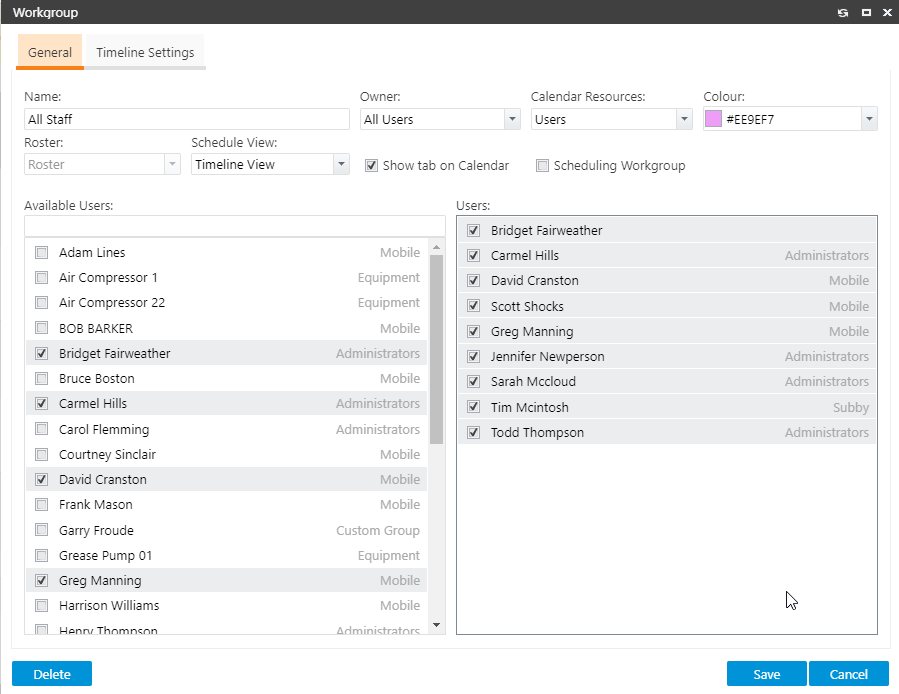
New Workgroup Calendar Resource ‘Jobs’:
Workgroups in TimeTrak are a selection of users, clients or queue items (Jobs/ Tasks) to display time entries and appointments, and to provide schedulers a visual overview.
In version 19.1, Workgroups were enhanced to allow queue items to display in a calendar view which you can read about in this Whitepaper.
In 21.2, an additional Calendar Resource, Jobs, has been added (see below). This provides the ability for jobs to be added to a calendar workgroup with the need for a job-based queue to be created.
When ‘Jobs’ is selected from the Calendar resources, the Available Jobs list shows all active jobs. This list can be searched by job number, client name as well as job title, although job title is the only visible field in this list.
Users can then select which jobs they wish to display. This will then be moved to the Jobs panel on the right hand side.
This type of workgroup will only display in timeline view, therefore the Roster and Schedule View is greyed out (see below).

The users that display in this view are dependent on the selected resources against the TimeTrak Resources tab in the job(s) screen, as per below.
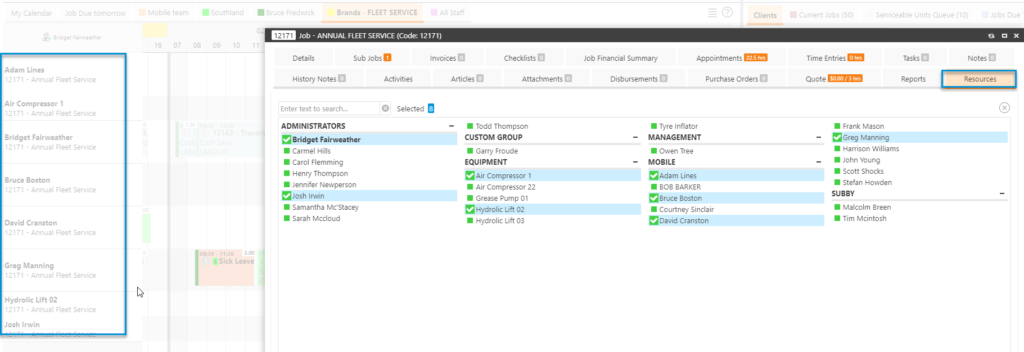
Time entries and appointments that are not against the job(s) in the workgroup are greyed out and unable to be adjusted from job workgroups.
Only Non-Billable, Non-Productive and entries against the selected workgroup jobs(s) are able to be amended via this type of calendar view.
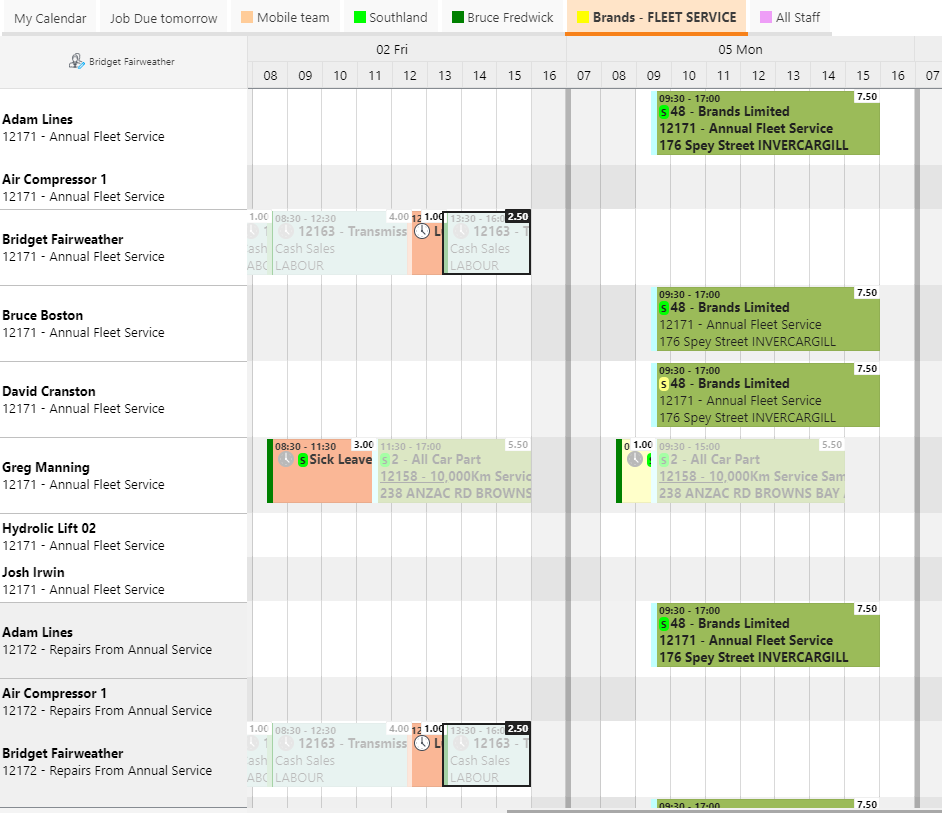
A working example of where this type of workgroup would be useful is for job managers who are responsible for the entries against specific jobs they manage.
This view gives a great overview of the resources assigned to the jobs as well as the entries that relate to the jobs they are managing.
Previously in TimeTrak, the ability to convert an appointment to a time entry was limited to a single appointment unless users ran the User Summary Report where multiple appointments could be selected and converted to time entries at once for a single user or group of users as per below:
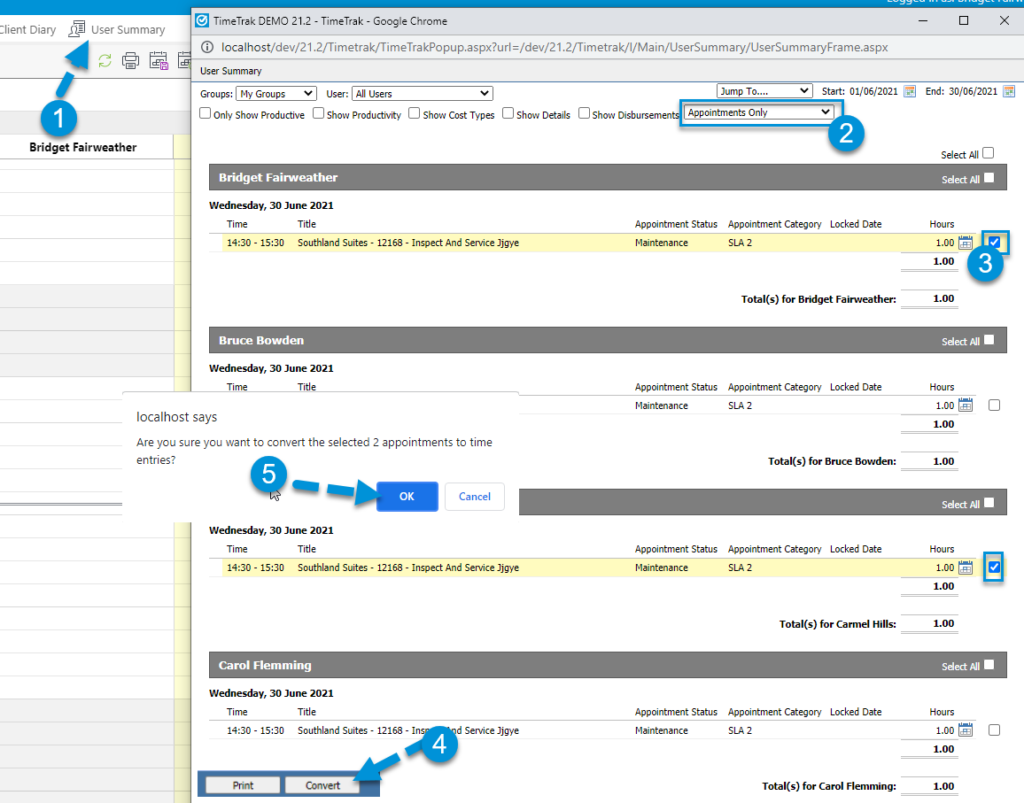
In TimeTrak from version 21.2 onwards, there is the ability for users to select multiple appointments via calendar views in Professional and convert to time entries.
To do this, users need to hold down the “Ctrl” button and select the appointment(s) you wish to convert.
Note: This adds a black outline to the selected item(s).
Users can then right click and select “Convert to Time Entries”, as per below:
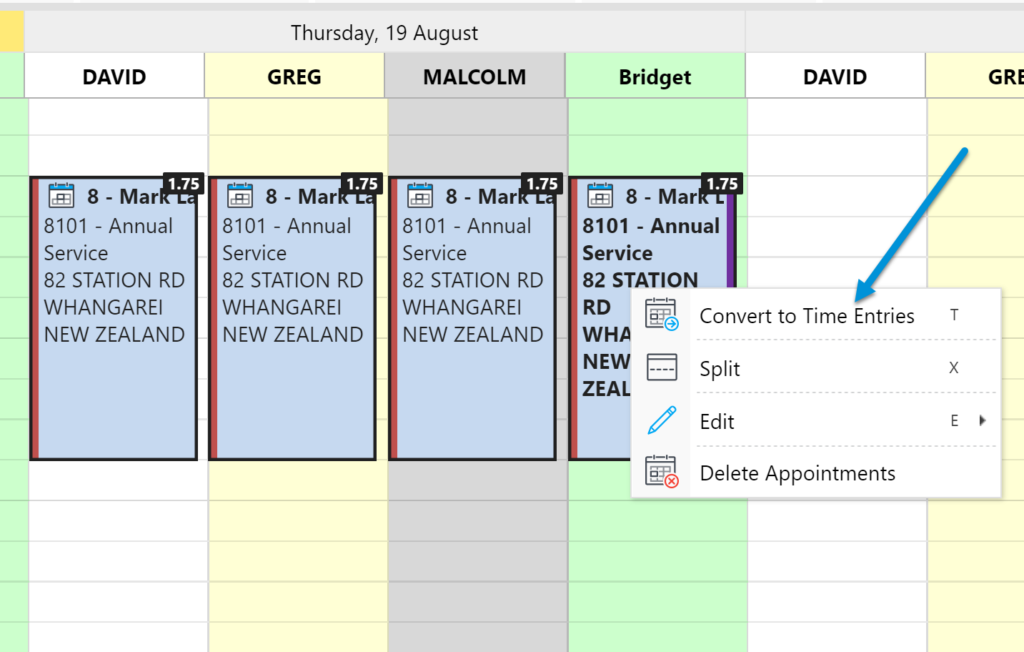
Which will pop a Confirmation window in order for users to confirm the conversion. Choose ‘OK’ to accept.
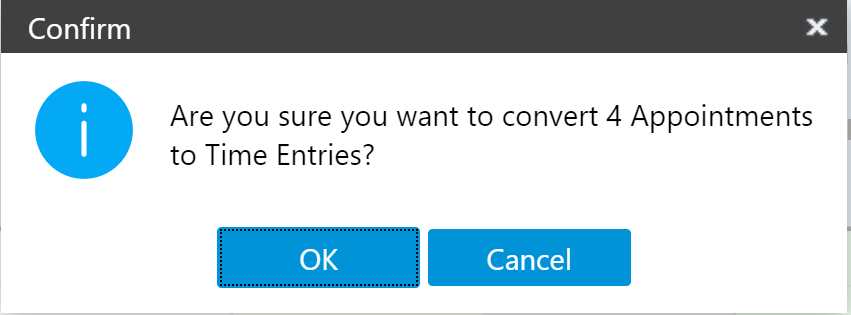
Appointments will then be converted to time entries using the user’s defaults or what was specified as the appointment default.
Note: If the user has breaks setup against their roster or in “My Breaks” (Professional users only) then on conversion these breaks will be inserted.
Users are only able to convert appointments to time entries in both methods if they have the profile setting “Convert Appointment to Time Entry” enabled against their profile, as per below:

To further enhance this process, hot keys have been included.
Users can hold down “Ctrl” and double click either an appointment or time entry, which will select ALL matching items for that day in the current calendar view.
I.e., in the below example, all appointments for the date have been selected (instead of the need to select these one by one):
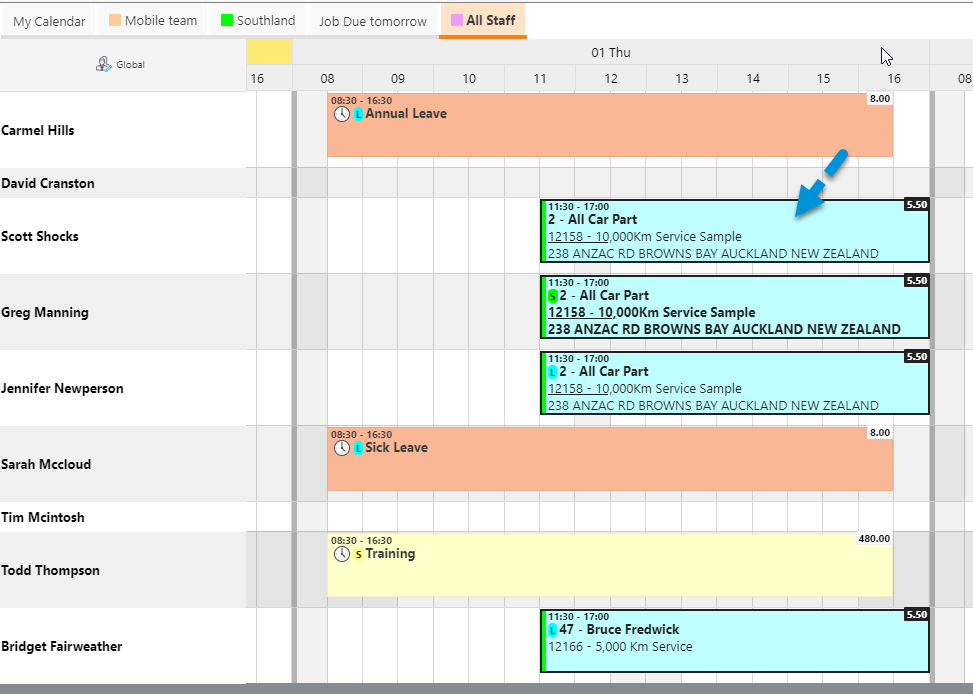
Users can also down “Shift” and click an entry and then another entry in the same row in order for the items in between to be selected by default.
I.e., in the below example, Shift was held down and Wednesday’s appointment was selected, then Friday’s (Thursday was selected by default).
Items that are different (time entries vs appointments) are ignored.

Similar to above where multiple appointments can be selected and converted to time entries via Right Click + Convert to Time Entries, a shortcut key of ‘T’ has been added to this function. This means that users can select and then click ‘T’ on their keyboard to get the confirmation pop up.

Appointment Shortcut Keys;
| Shortcut Key | Function |
| J | Job – This is a new feature which pops a job selection to change the job selected appointment(s) are assigned to |
| C | Appointment Category – Provides the ability to set the appointment category of selected appointment(s) |
| S | Appointment Status – Provides the ability to set the appointment status of selected appointment(s) |
| Shift + S | Appointment Job Status – Provides the ability to set the appointment job status of selected appointment(s) |
| T | Convert – Converts selected appointments to time entries |
Time Entry
| Shortcut Key | Function |
| V | Verify selected time entries
Note: This option is dependent on the logged in user having permission to verify the selected entries, and those entries requiring verification. |
| U | Un-verify Selected time entries
Note: This option is dependent on the logged in user having permission to verify the selected entries, and those entries already being verified. |
| G | Cost Group – Provides selector to set the Cost Group of selected time entries. |
| T | Cost Type – Provides selector to set the Cost Type of selected time entries. |
| O | Quote Option – Provides selector to set the Quote option against selected time entries.
Note: Not available when selecting entries against multiple jobs |
| L | Labour Code – Provides selector to change the Labour Code against selected time entries.
Note: Not available when selecting entries against multiple users. |
| S | Billable Status – Provides selector to change the Billable status against selected time entries.
Note: Not available when selecting entries against multiple jobs |
Shared – available for both Appointments and Time Entries
| Shortcut Key | Function |
| X | Split – Splits selected appointments/time entries in half. |
| E | Edit Menu – Pops the edit options quickly without the need to drill through the ‘edit’ option |
| F | Fill Day – This is a new feature where if selected will populate Time Entries when the start time is in the past and Appointments when start time is in the future |
| Shift + F | Fill Day (same as above, but will use current user’s default job if set) ** |
**Note: a user’s default job is located against their user profile, as per below:
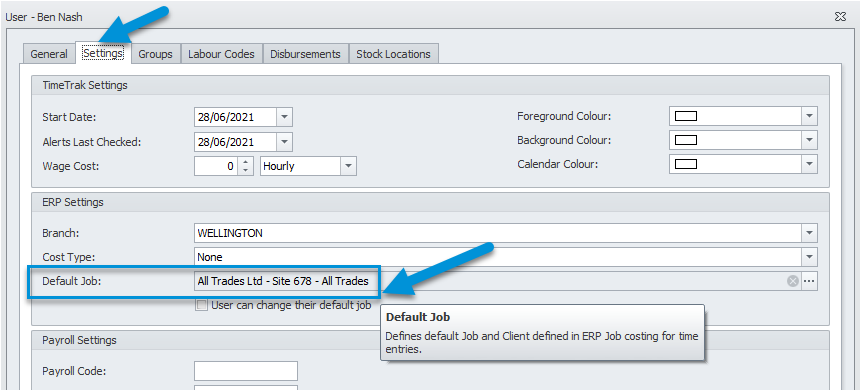
These shortcut keys have been added into the Legend with the TimeTrak Professional website in order to be referenced easily, as per below.
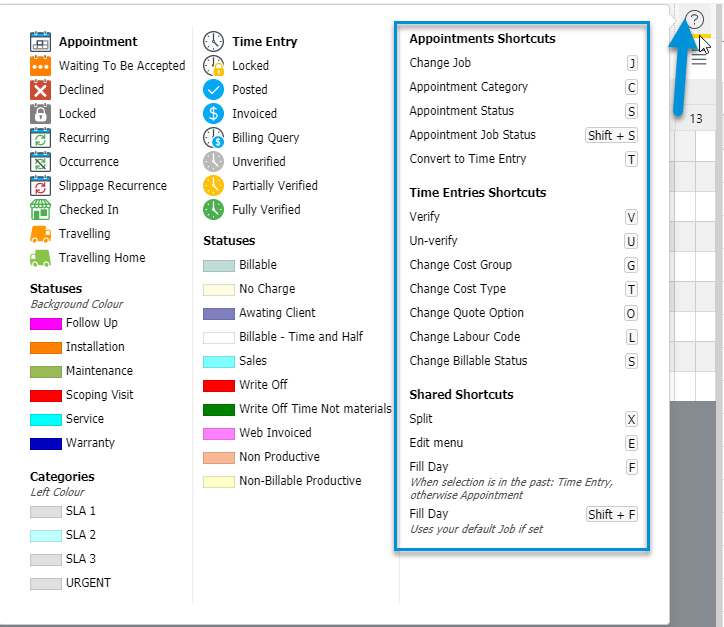
Rosters were introduced to TimeTrak in version 4.0. For more details refer here.
Rosters were then moved into TimeTrak Professional for Global Administrators to add/amend in version 19.3.
Previously if roster classes were in use, there was no ability to override this should the user have started early and finished outside of their normal work hours.
In version 21.2, this has been adjusted so that the roster class rules will only run on insert of the time entry but on edit this can be amended.
Against Roster Classes, there is now also the ability to specify a colour (see below):
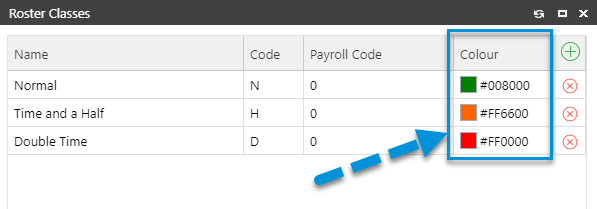
Bridget is assigned to her own roster that is setup for her to be paid double time on Sunday and time & half Monday to Friday outside of her normal working hours, as well as all day Saturday.

Against her user profile, this is mapped to the applicable labour codes, as per below:
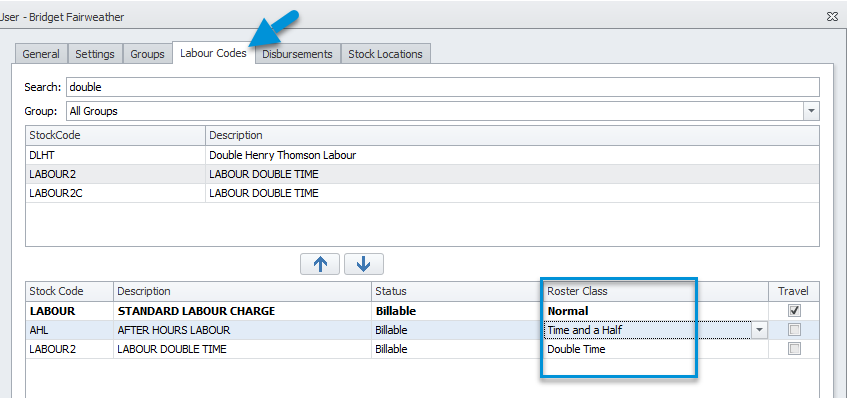
With this set, when Bridget adds a time entry from 7:30am – 4pm, by default the time entry will be split into time and a half and normal time using the labour codes specified against her roster above.
The colour set against the Roster Class is also visible against the time entry on the left side bar across all Professional calendars to indicate to staff the roster class (or pay rate) the entry has gone to.

In 21.2, there is the ability to edit time entries to another roster class (pay rate) and the roster class rules will not run again to override this. This provides further flexibility and flexible working hours within TimeTrak.
The Roster Class the time entry is mapped to can be exposed on Non-Billable time entries by enabling the new profile setting “Show Roster Classes”, as per below:
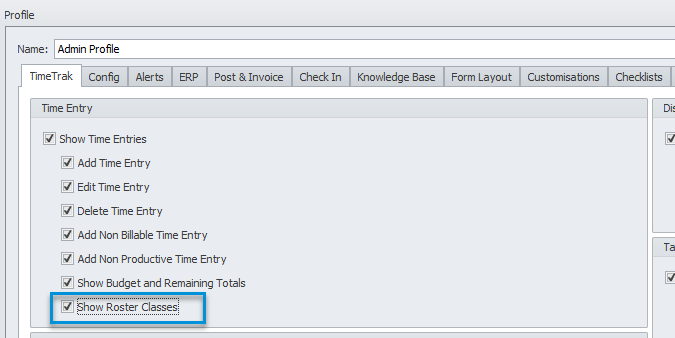
This provides great flexibility for clients who are also using TimeTrak data for payroll purposes. Especially in instances where Non-Billable time would be paid at overtime rates if it is required outside of normal working hours.
I.e., training, as per below. The time entry side bar which maps to the roster class also assists to see this in the calendar clearly.

In many sites the labour code used does not reflect the time the employee should be paid.
In these sites, often the billable status defines the pay rate (which can have the correct payroll code or Wage type applied against the billable status for those using the export to payroll function also).
An example of this, click here.
In order for these sites to take advantage of the roster class changes and provide graphical overview of hours to be paid and what payrate via payroll there is also the ability to default the roster at the billable status level instead of being based on the labour code used.
If this is the case, the below global setting should be enabled:
It is important to note, when using this method all rosters should have all units set to “Normal” otherwise errors will occur on save if the roster rules are trying to run and look for a labour code to match the selected roster.

Once enabled, the roster class can be mapped against the applicable roster class, as per below:
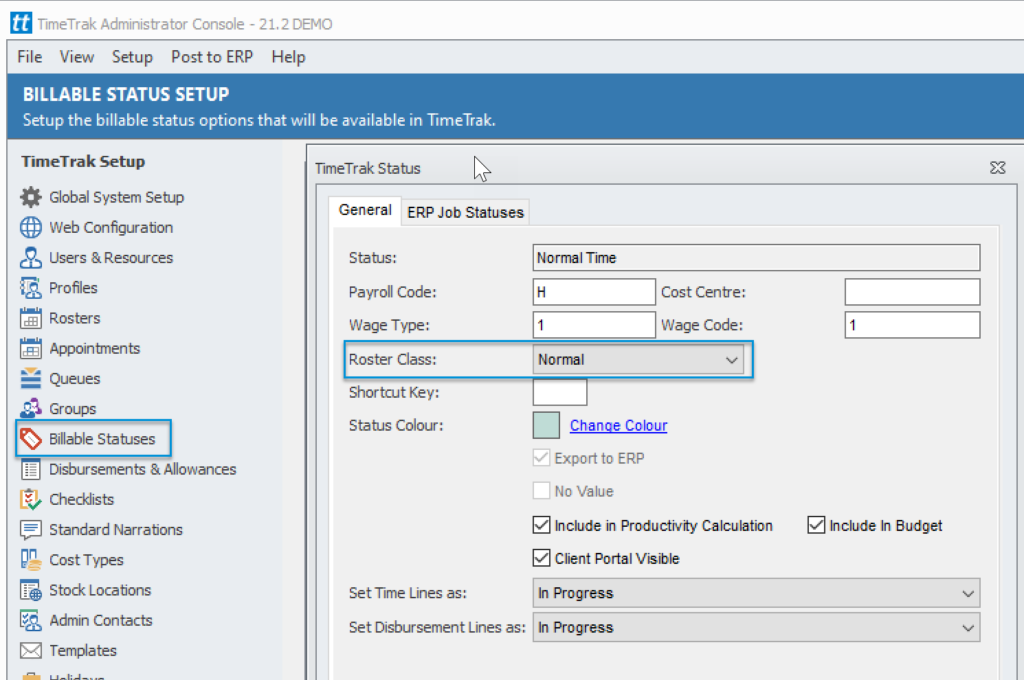
Against labour codes of a user there is a notice to advise users that the roster class will be defined by the billable status (with this enabled all rosters should be set to Normal IE: different times can not be set to different roster classes)
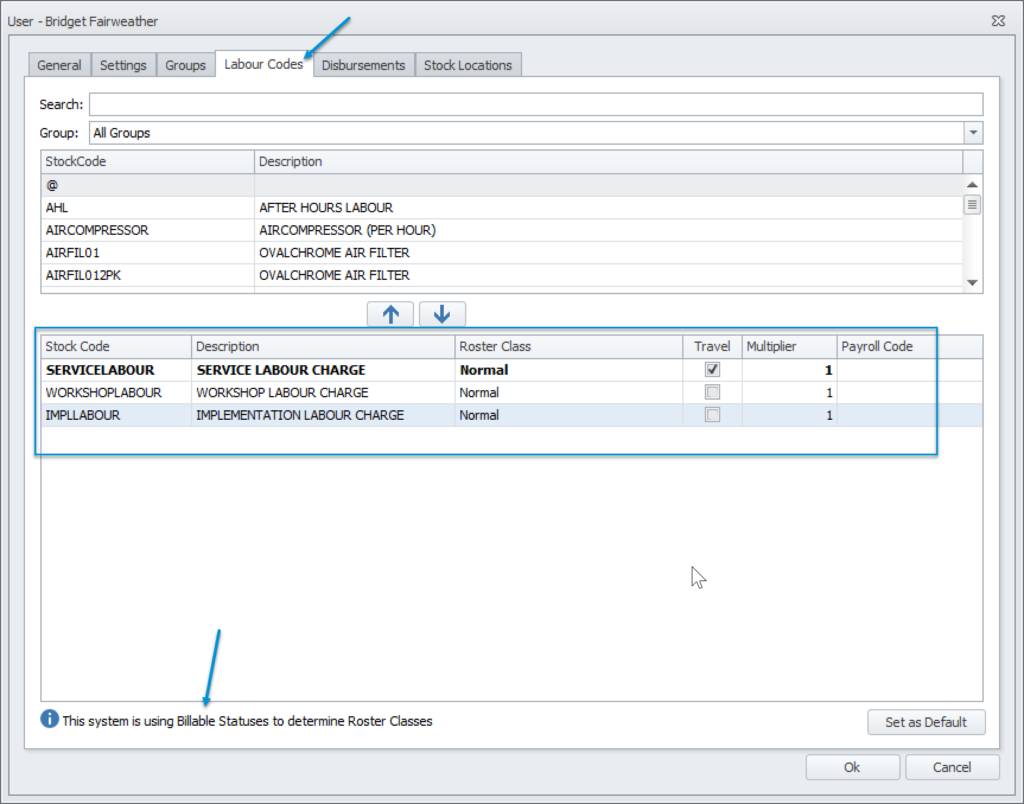
On Time Entry creation against users when the billable status is changed to reflect how the user should be paid the roster class against the billable status will be set providing payroll staff to ensure this data is set correctly.
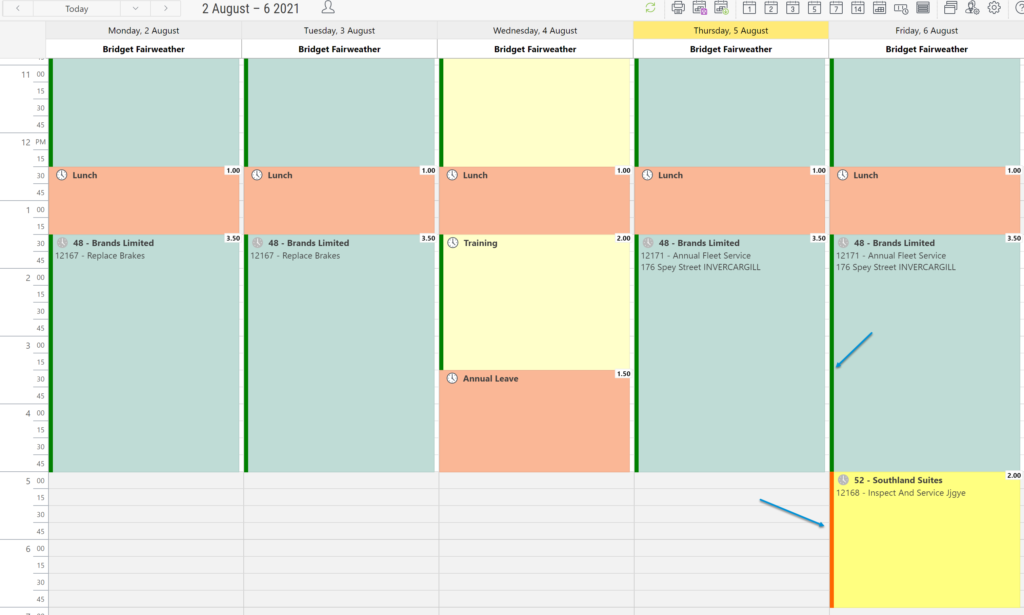
This flows through to day and payroll totals in time line views as well as per below:
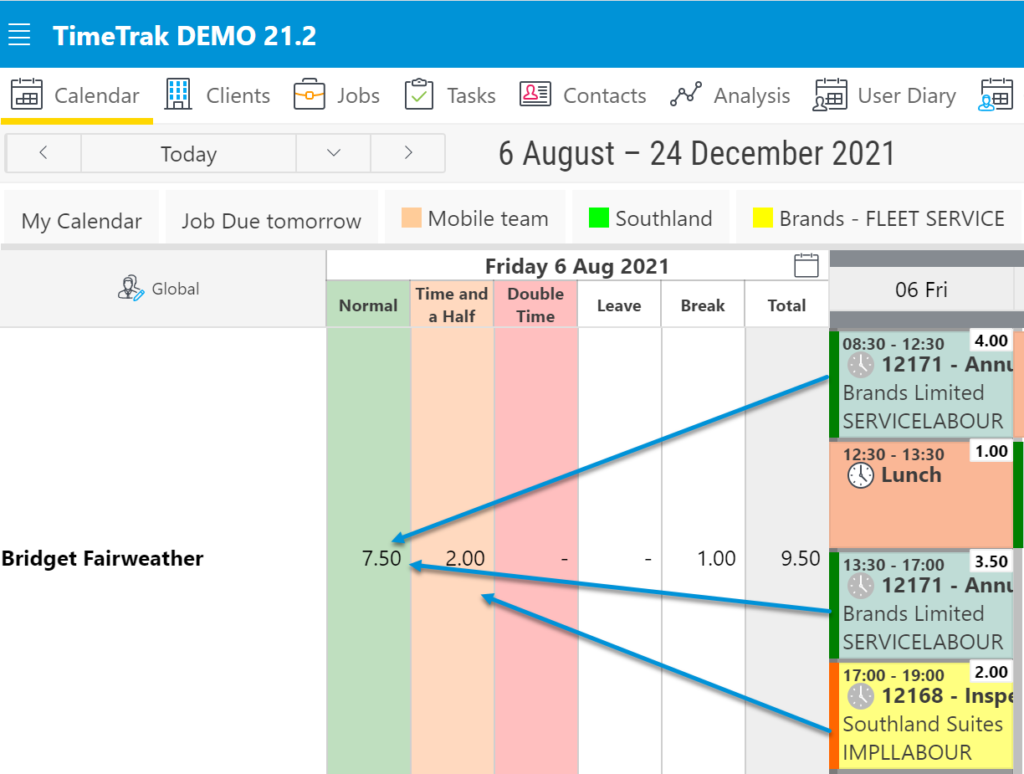

In the first release of 2019, (19.1) a lot of work was done to the timeline view within TimeTrak. Refer here for details of Timeline settings and functionality.
In 21.2, additional settings have been added to Timeline Settings:
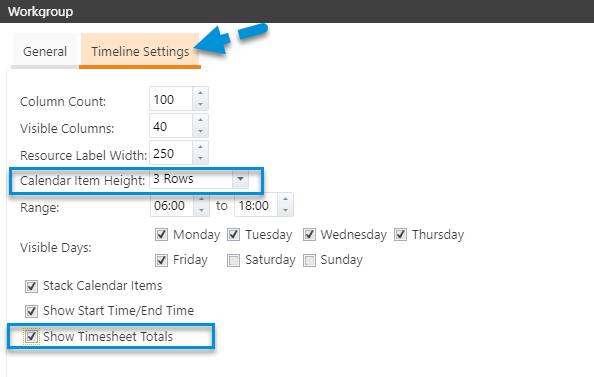
Calendar Item Height:
This setting defines the height of calendar items within the timeline view.
Usually, this would be set depending on the amount of rows you have displaying data in your user’s profile customisation setting, as per below:
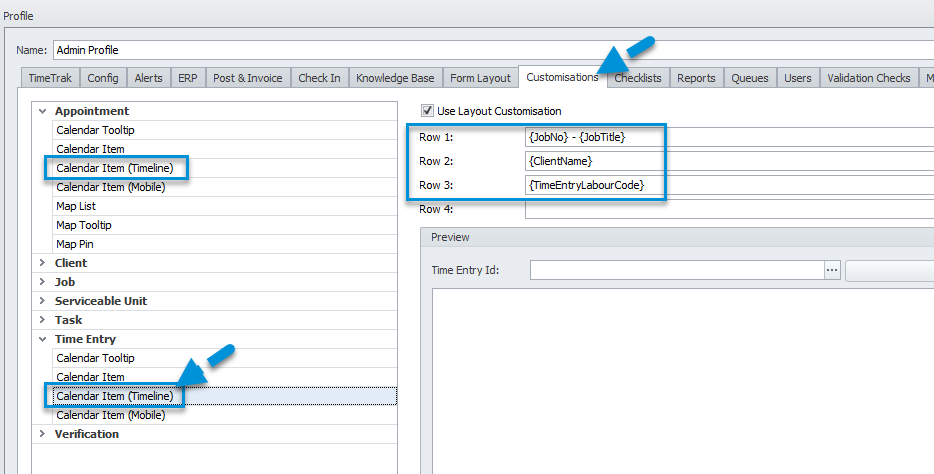
The default for this setting will be “Automatic”, which is the old behaviour where Non-Billable and Non-Productive entries that do not have the same data are not in line with job-based entries (see below):
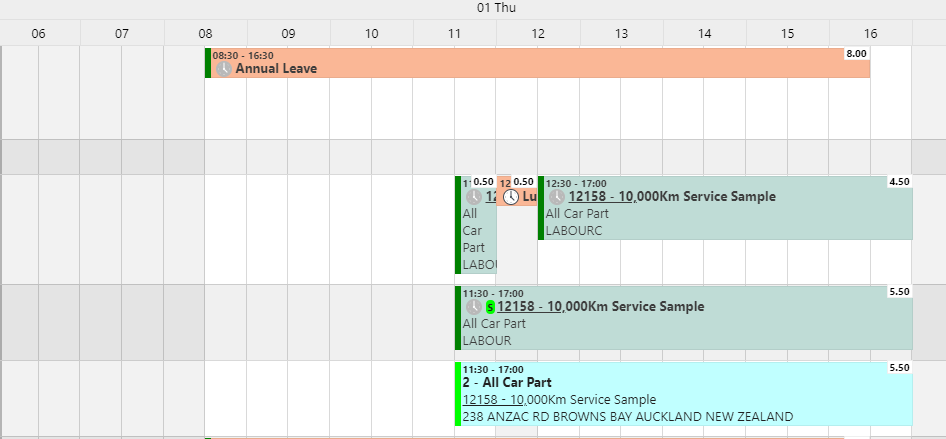
Show Timesheet Totals:
This setting continues to enhance roster class changes.
With this setting enabled, in the timeline view the resource label width will adjust to 500.
Note: If you have more than three roster classes, then you will need to manually adjust the resource label width to allow additional roster classes to show.
Total hours per user for the first day on the timeline calendar are calculated against the roster class with the roster class column being a dulled colour of what is set against the roster class (as per point 5 – Changes to Roster).
In the below example, users are assigned to a roster with a daily minimum of 7.5 hours.
The total column colour changes based on the below:
- Grey = Daily minimum hours have been meet or exceeded.
- Red = Daily minimum hours have not been meet.
- Green = Daily minimum hours have been meet and verified.
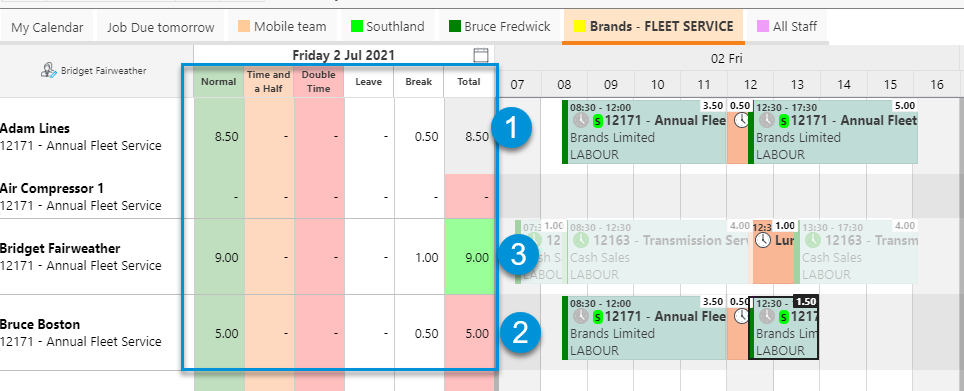
The Leave column is populated with total Non-Billable time entries.
The Break column, which is excluded from the total, is populated with total time entries against a time analysis marked as ‘break’. Breaks in TimeTrak are covered here.
For clients who use TimeTrak data for payroll purposes, it is important to see totals not only a daily total but also via pay period. Clicking the new Pay Period icon within Timesheet Totals below;
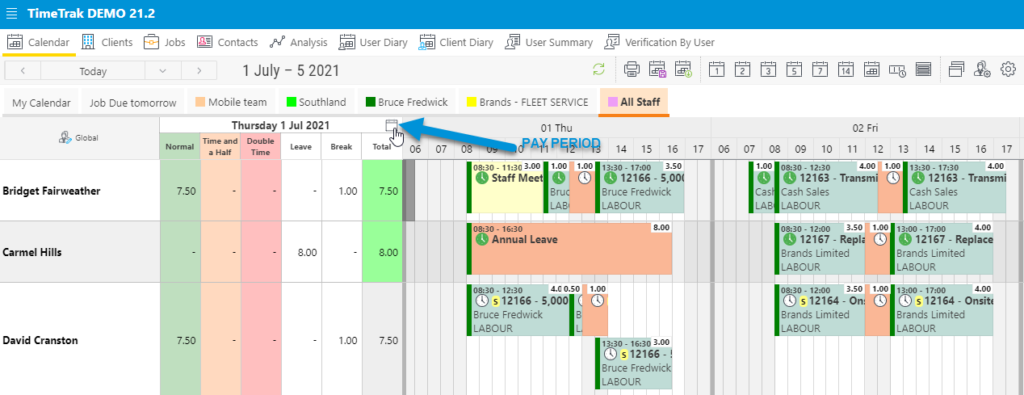
Pops the workgroup calendar out to a separate browser window for the selected date range’s pay period.
This has all the same behaviour from Timesheet Totals but in a week view to assist payroll staff managing hours for payroll.
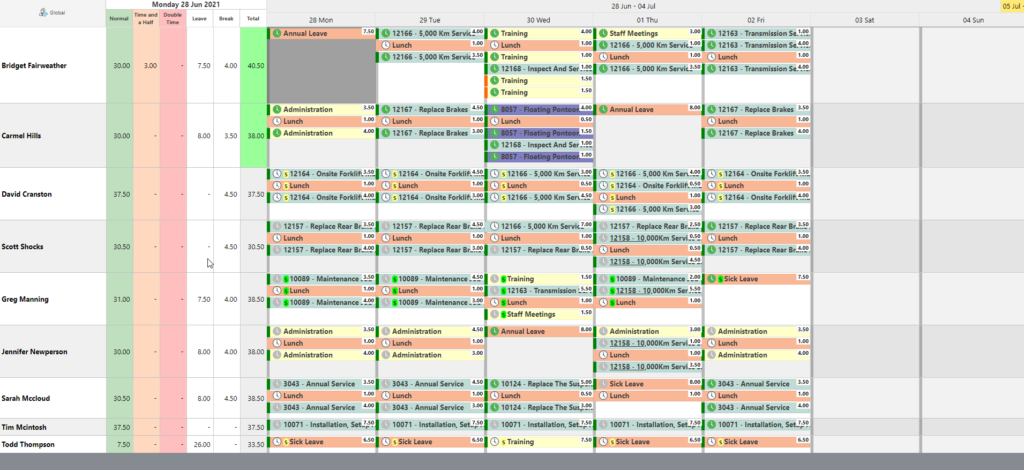
This information comes from the Global System Settings Payroll Frequency and First Date of Pay Period as per below:
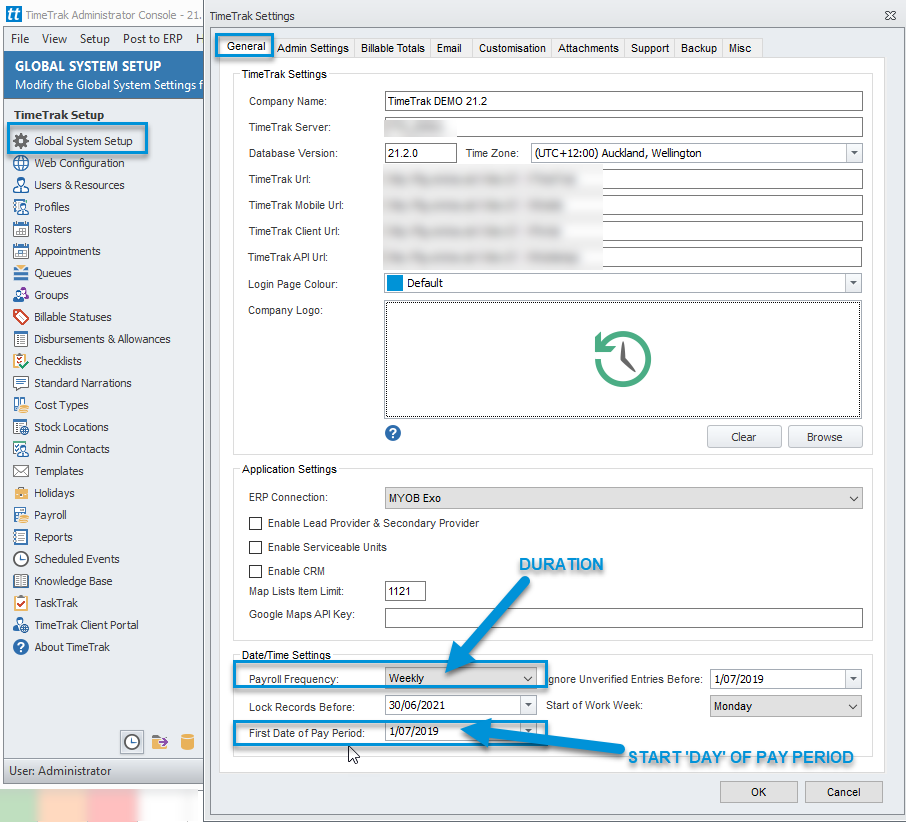
In the below example the timeline view was on Thursday 1st July. One week displays due to Payroll Frequency being set to Weekly. The Pay period starts from Monday 28th June due to the First Date of Pay Period being set to 01/07/2019 (which was a Monday).
6 Minute Scales / Captions added:
As per below, both 6 minute timescale and captions have been added to the timeline view.
This is a great addition to clients using TimeTrak for payroll data where a 38 hour week (7.6 hour work day) requires time to be recorded in 6 minute time units.
This provides the ability to select and schedule / record a 7.6 hour work day via timeline views easily.
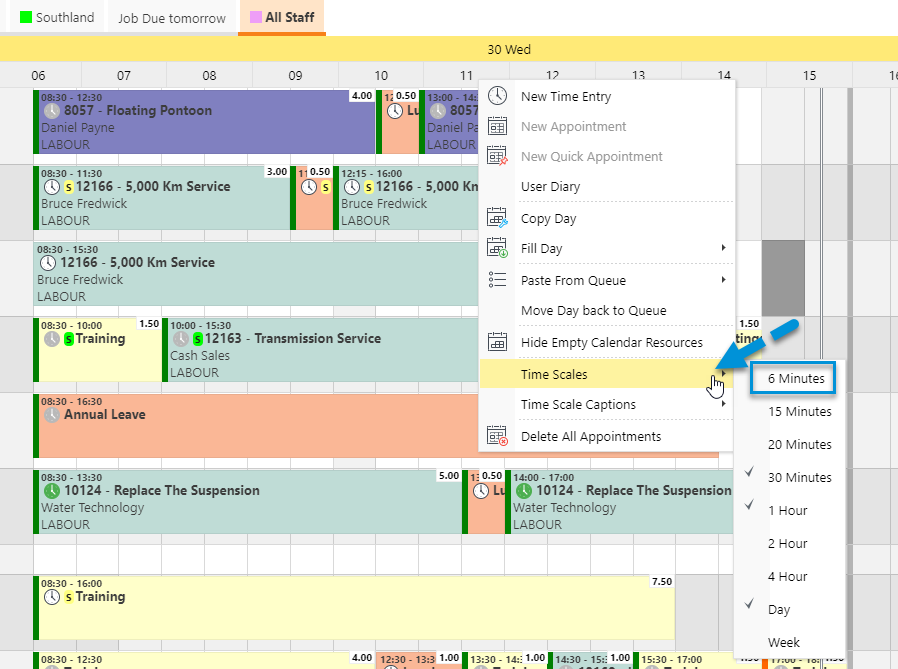
In TimeTrak Professional from 21.2 onwards there is now a colour selector against a client, as per below:
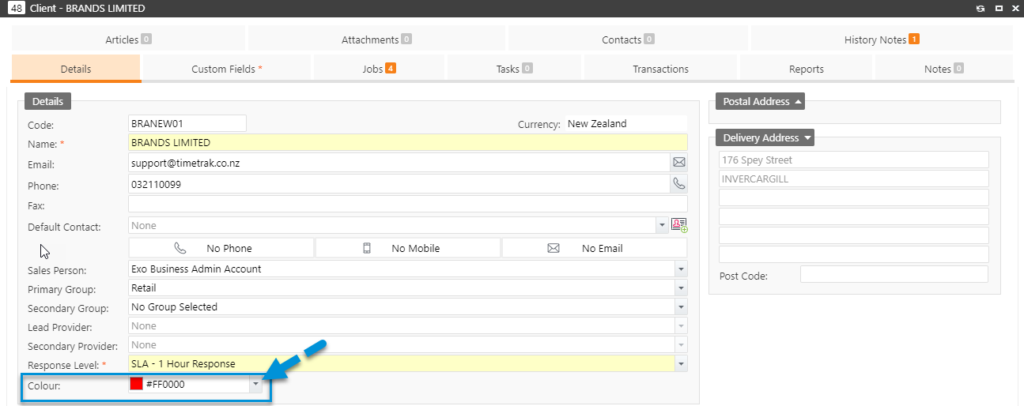
Client Colour is now available in the appointment colours configuration in order for clients to colour code their appointments based on the client the appointment is for (see below):
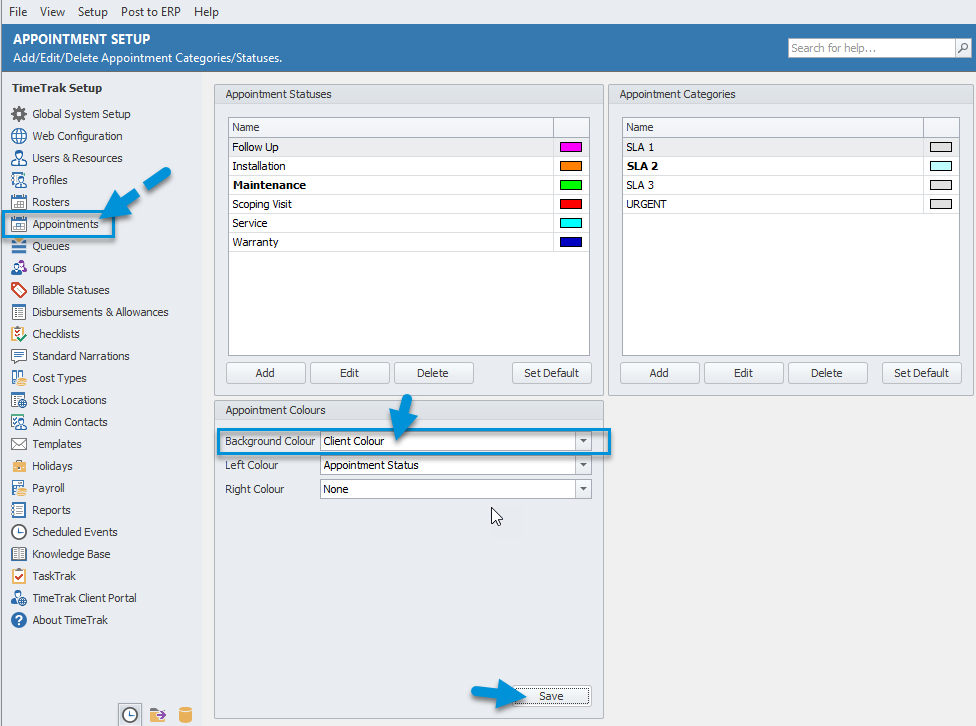
In TimeTrak Professional from version 21.2, users now have the option to ‘Pin Job’ via the right click menu of existing time entries and appointments in the calendar, as per below:
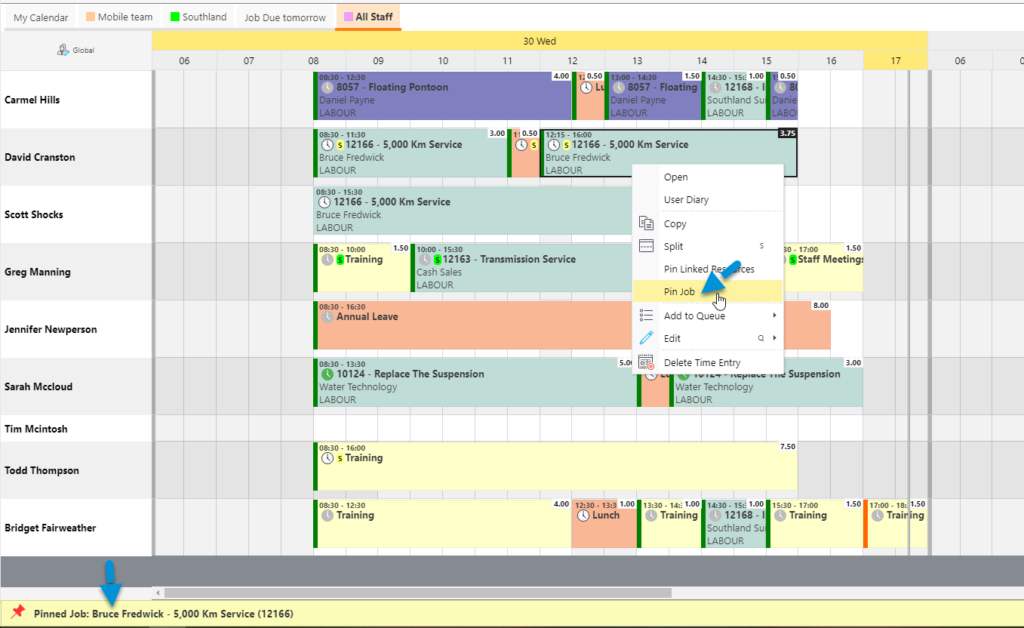
This provides the ability for the job to be easily scheduled again for the following day or for a selection of other employees.
With the release of 21.2, the below additional default user fields have been added to all users:
- Job Title
- Mobile
- Phone
- Extension
- Date of birth
These fields are available to view and populate within the Admin Console, see below:
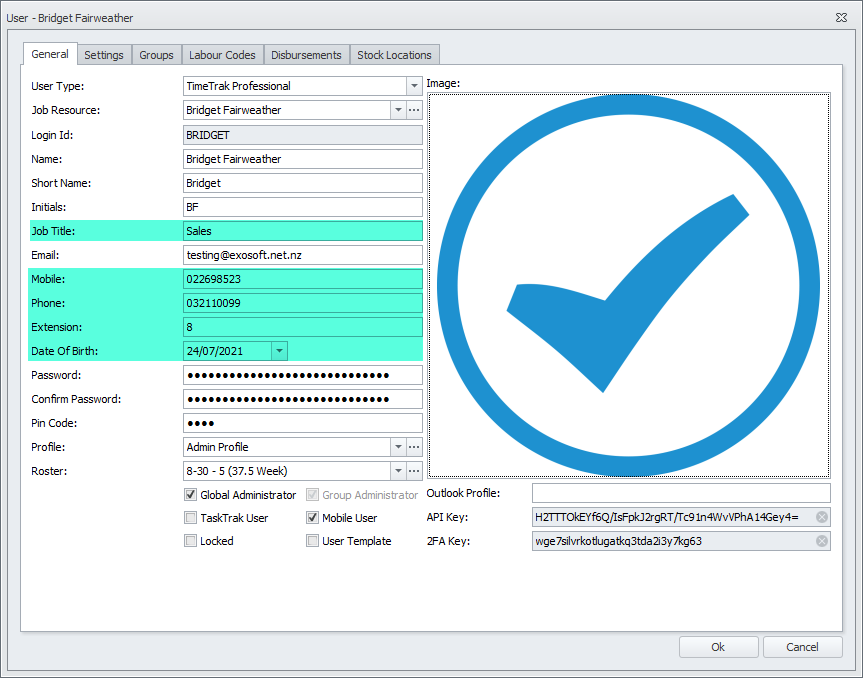
Global Administrators can also view/amend these fields against users via the Professional website now under Settings > Users (see below):
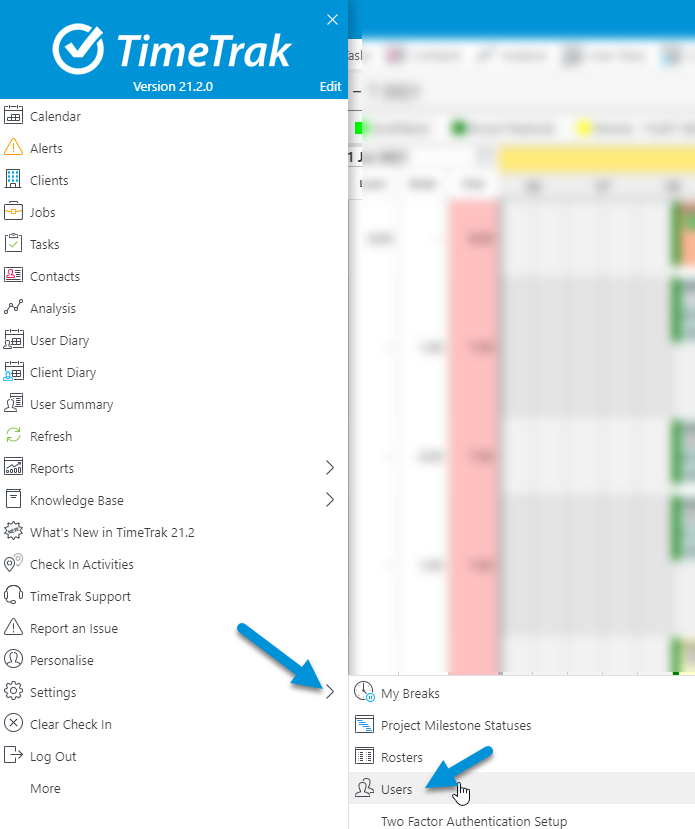
This will load a user grid where Global Administrators can search employees to review their information as well as update user settings such as PIN code, password, profile roster etc. as per items highlighted below:
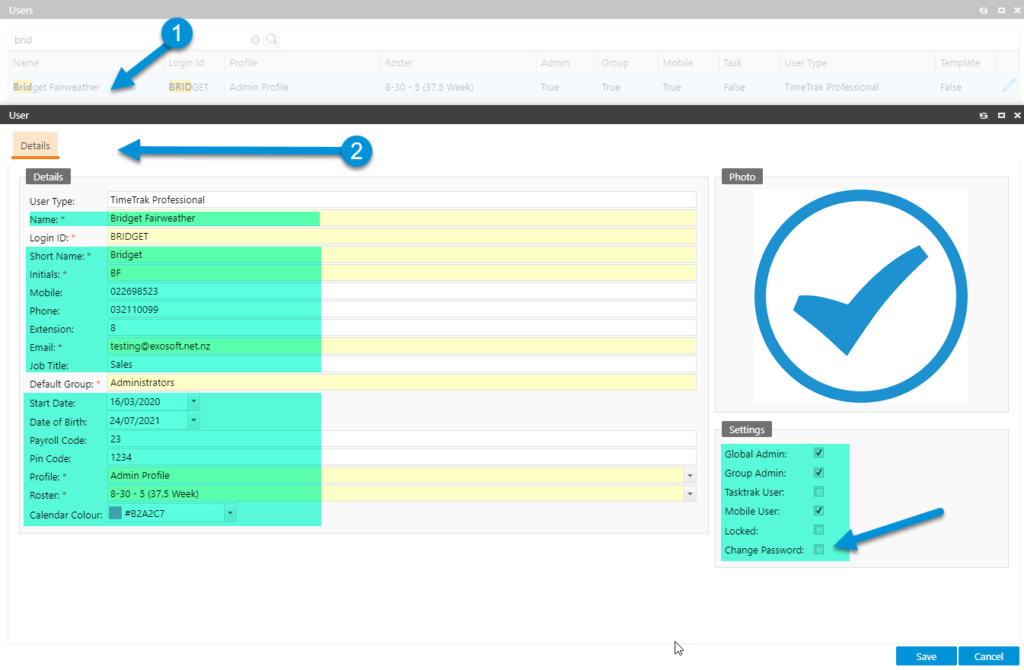
Additional custom fields can now also be added to the database with assistance of your TimeTrak Consultant to house additional information about your employees within TimeTrak.
Custom fields that are added will display against users in Professional on a custom tab.
In TimeTrak Professional across all calendar views, double clicking a user pops out the selected user’s calendar, as per this Tip of the Week.
From 21.2, there is now also the ability to ‘hover’ over the user and see a tool tip containing information against this user (see below) with tool tip options to “Edit” user information or open the user’s diary.
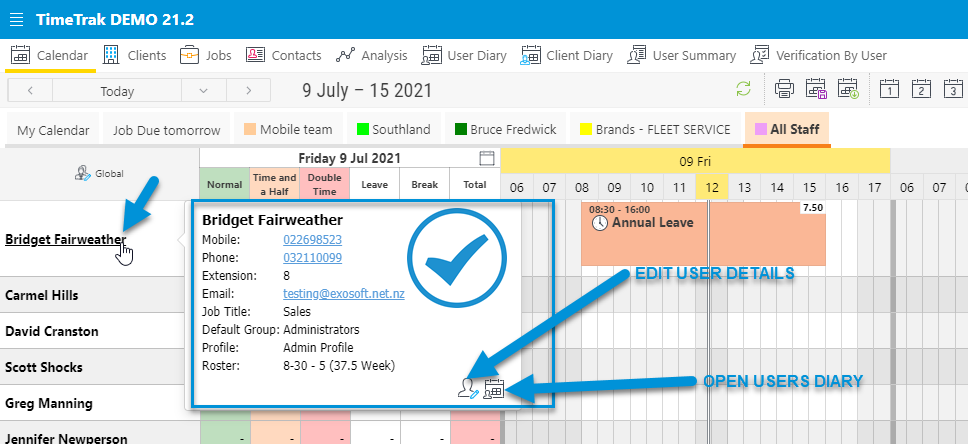
This tool tip is unable to be customised but will display the below information if it is populated:
- Username
- Mobile
- Phone
- Extension
- Email
- Job Title
- Default Group
- Profile
- Roster
- User Image
As well as any custom fields which may be setup against users.
In TimeTrak release 19.3, a lot of changes were made to Verification including the ability for multi-person verification. Refer here for this information.
In this release verification features have been enhanced further.
- Ability for Partially verified items to be edited
Previously, when an entry that required two person verification, was partially verified it was locked from being edited meaning the second verifier would require the first to un-verify the entry before they could make required changes before both staff would need to verify the entry again.
This has now been adjusted so partially verified items are able to be updated until they are “Fully Verified”.
Note: All changes are logged in the activities tab of the entry
2. Updated Time Entry icons based on the verification status/ requirement
Not all time entries require verification in some businesses.
To reflect this, an additional Grey coloured clock icon has been added to TimeTrak Professional to indicate time entries which require verification that have not yet been verified.
The previous white Time Entry clock icon will now be displayed against time entries that do not require verification (Lunch for example).
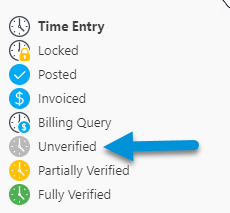
3. Ability to right click time entries in the calendar view to Verify or Unverify
If the logged in user has the ability to verify time entries this can now be done from the calendar view in TimeTrak Professional via a right click.
As per below, a Verified entry only has the option to Un-Verify and an Un-verified entry only has the option to Verify.
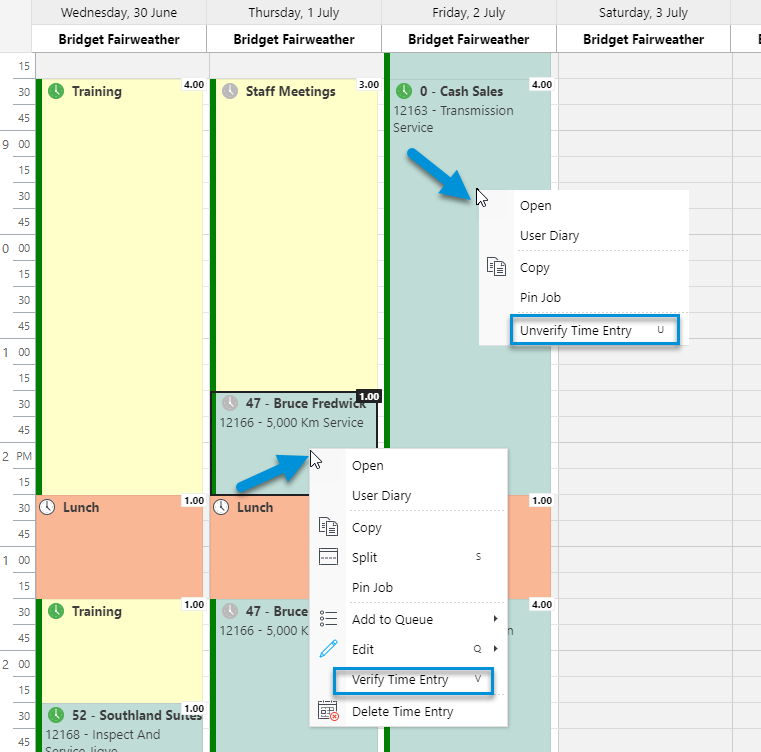
As mentioned here, this can be done across multiple time entries in the calendar view as well as via new shortcut keys.
4. Job Manager Verification Non billable and Non Productive entries now default to “Any user” verification
Previously, if users had their profile verification set to only “Job Manager” but also required Non-Billable and Non-Productive entries to be verified as per below:
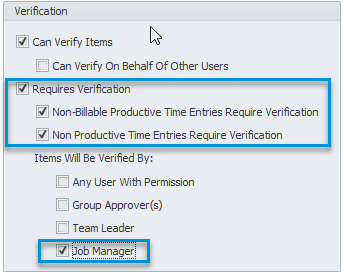
Non-Billable and Non-Productive entries would display as “Unknown” and would be unable to be verified in the Verification by User reports as there is no job manager for these entries.
This has now been corrected. Profiles configured as per above with Non-Billable and Non-Productive entries will default to verification by “Any User” allowing these to be verified.
5. “Can Verify On Behalf Of Other Users” provides the ability to edit any already verified entry
Users who are assigned to a profile with “Can Verify On Behalf Of Others” enabled (see below) have the ability to edit fully verified entries.
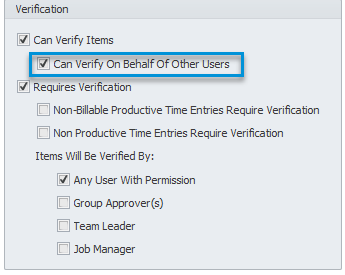
The changes that these users make are logged on the Activities tab of the time entry meaning there is an audit trail of changes made.
A working example of a user who may have this permission would be a payroll administrator in businesses where managers or team leaders are responsible for verifying users hours against jobs and it is up to the payroll administrator to ensure these hours are recorded at the correct pay rate (roster class).
In order to provide even further flexibility across different businesses within release 21.2, there is now three “Fill Day” options which can be specified at the profile level (see below).

For more information on these three options and what they provide, please refer to this Whitepaper.
TimeTrak introduced the ability to save “draft” checklists in version 4.0. Refer here for further information.
Draft checklists provide the ability for a user to complete a section of a checklist and save this as a draft in order for another user to complete, or the same user to complete the checklist at a later date.
Against a checklist in the Admin Console, it is defined if the checklist has the ability to be saved as a draft in the save behavior setting below:
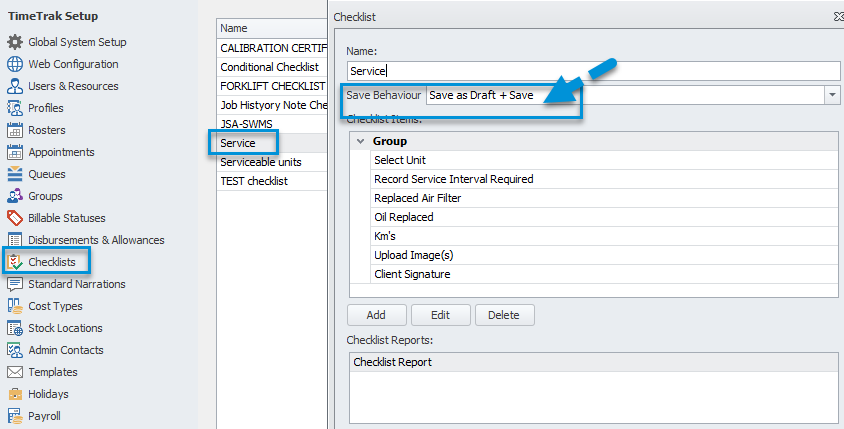
Draft checklists can be seen against the Job/Task to which they have been saved in order for other staff to review the progress of the checklist and complete further, if required.
A working example of why draft checklists would be useful is a site who may ‘run up’ equipment before it can be sent to site.
A technician may start this process and then get called away to another job.
If this process was saved as a draft checklist, another technician could pick up where the other left off and continue on through the checklist without any ‘down time’ whilst trying to see how far through the technician/other user got.
Draft checklist behavior has been enhanced so that draft checklists can now be included in event-based checklists across multiple users.
Previously, users would need to manually go the checklists section of a job/task where they could see if any draft checklists were available and select from here to run.

In 21.2, on a profile against a checklist event (for a checklist that has save behavior of “Save as draft”).
There is an additional setting “Allow draft to be completed by another user”, as per below:
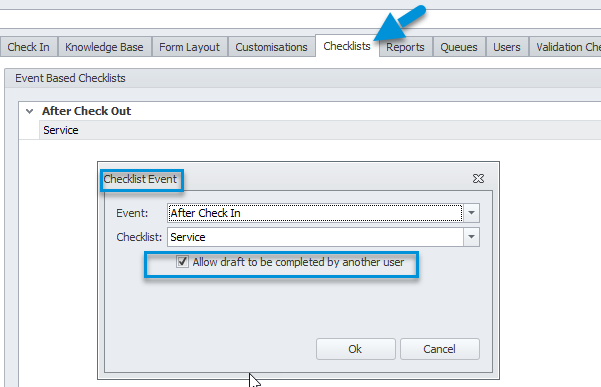
With this setting enabled, if a user against this profile actions the event when the checklist fires it will look to see if there are any drafts against this job/task and select the most recent (if multiple exist).
The most recent draft checklist will then display for the logged in user to continue with instead of manually needing to select the draft which may lead to it being forgotten or multiple draft checklists being in use.
An additional Global System Setting “ERP Connection” has been introduced with this release.
When the Connection is set to MYOB Acumaticad, as per below:
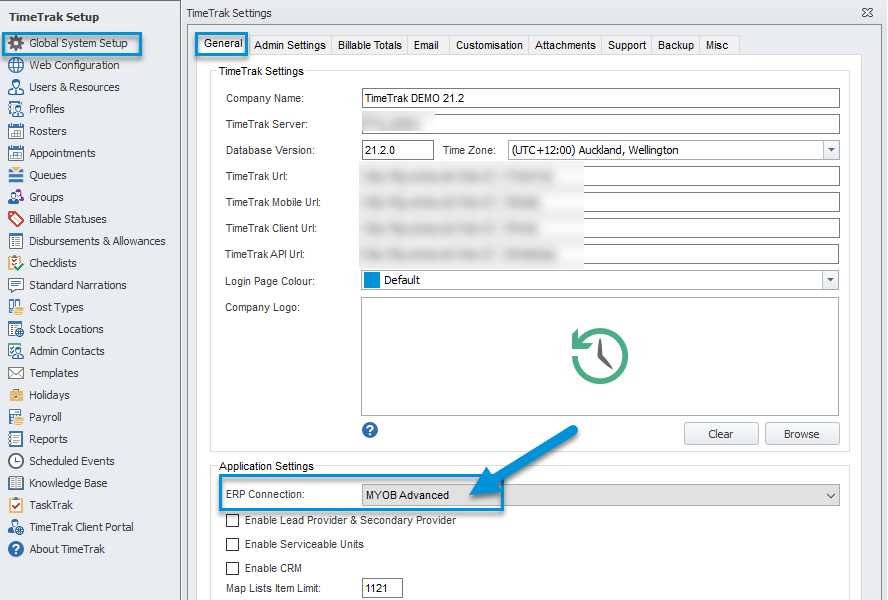
When users are assigned to a profile with “Show Job Quote Lines” and “Add Job Quote Lines” enabled;
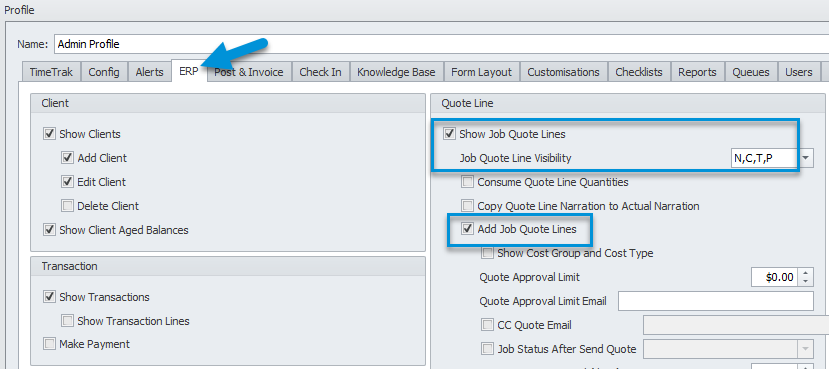
Job Quote lines will display a new field “State” in both TimeTrak Professional and TimeTrak Mobile.
Note: This field is only visible on Add or Edit of a quote line in Mobile.

The two options for quote line state are “Quoted” and “Confirmed”.
Quote lines with the state of “Quoted” stay within TimeTrak for record keeping purposes. Quote lines with the state of “Confirmed” sync back into MYOB Acumaticad Projects as two lines separating the cost and revenue from the single line in TimeTrak.
The cost of the line will land on the project as a Cost Budget line and sell of the line will land on the project as a Revenue Budget line.
This provides great flexibility for businesses who provide quote options and only wish for those options that are accepted to be in their ERP System (MYOB Acumaticad) without losing record of all options that the client was quoted.
To change the state of a quote line in TimeTrak Professional:
- Users can click to edit a single quote line, update the State and click Save, as per below:
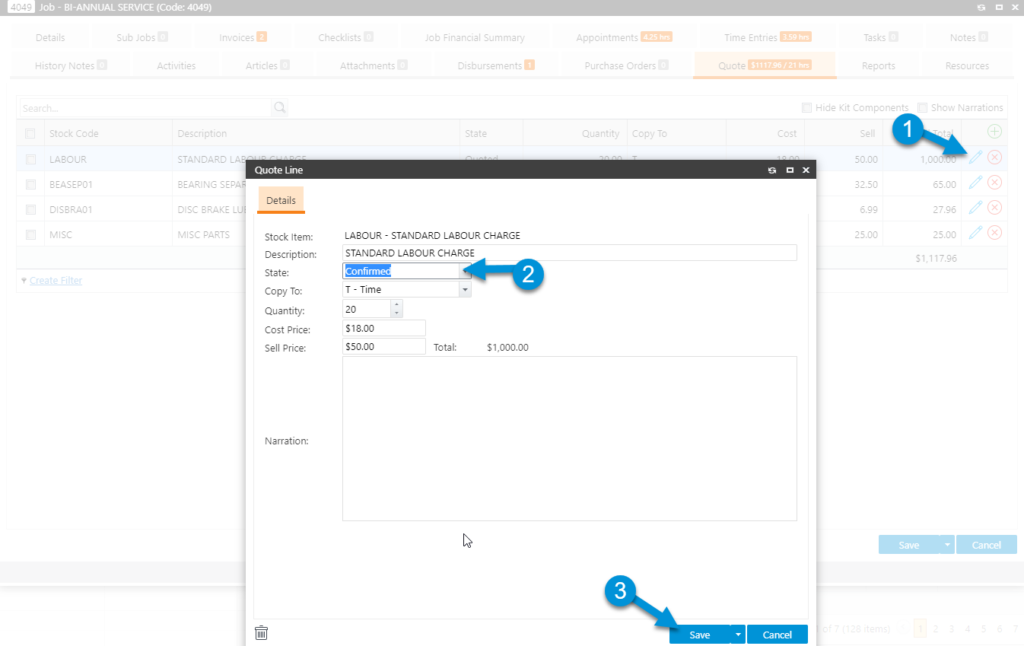
2. Users can also right click a single quote line Change State as per below:

3. Users can also update the state of multiple lines at once within TimeTrak Professional by selecting the lines, right click, Change State;

To change the state of a quote line in TimeTrak Mobile:
Users will need to select the applicable quote line:
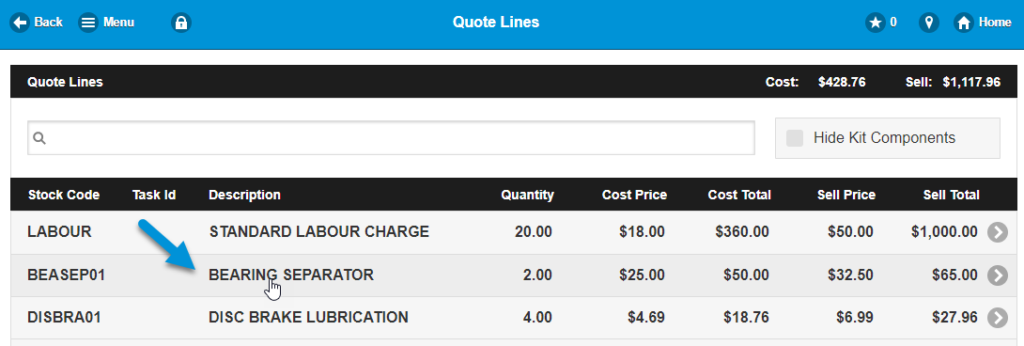
Select “Edit Quote Line”:
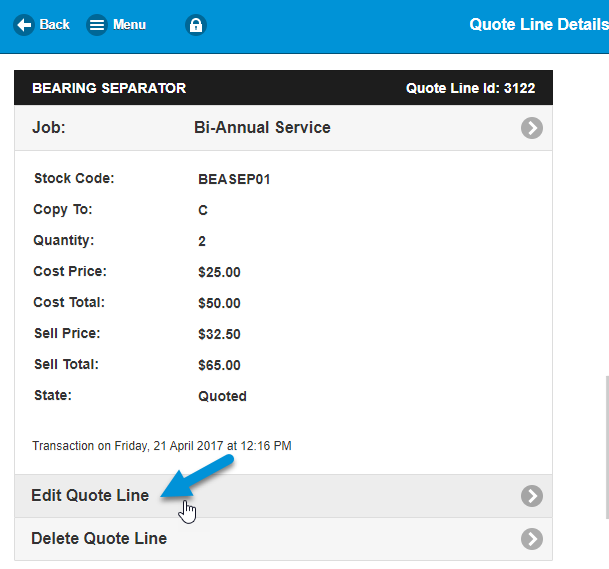
And update the State drop down field from “Quoted” to “Confirmed”, then click Save.
